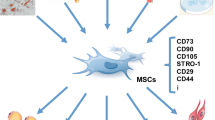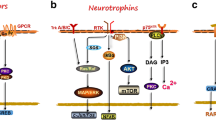Abstract
Increasing evidence has demonstrated that mesenchymal stem cells (MSCs) have been linked to tissue regeneration both in vitro and in vivo. However, poor engraftment and low survival rate of transplanted MSCs are still a major concern. It has been found that the proliferation, survival, and migration of MSCs are all increased by hypoxic preconditioning. However, the molecular mechanism through which hypoxic preconditioning enhances these beneficial properties of MSCs remains to be fully investigated. Therefore, the present study is aimed to investigate the mechanism by which hypoxic preconditioning enhances the survival of MSCs. We used proteomic analysis to explore the molecules that may contribute to the survival and proliferation of hypoxic preconditioned (HP) MSCs. The analysis revealed a higher expression of prelamin A/C (Lmna), glutamate dehydrogenase 1(Glud1), Actin, cytoplasmic 1(Actb), Alpha-enolase (Eno1), Glucose-6-phosphate 1-dehydrogenase (G6pd), Protein disulfide-isomerase A3 (Pdia3), Malate dehydrogenase (Mdh1), Peroxiredoxin-6 (Prdx6), Superoxide dismutase (Sod1), and Annexin A2 (Anxa2) in HP-MSCs. These proteins are possibly involved in cellular survival and proliferation through various cellular pathways. This research could aid in understanding the processes involved in hypoxic preconditioning of MSCs and designing of cell-based therapeutic strategies for tissue regeneration.



Similar content being viewed by others
Data Availability
Yes.
Code Availability
Not applicable.
References
Poomani, M. S., Mariappan, I., Perumal, R., Regurajan, R., Muthan, K., & Subramanian, V. (2022). Mesenchymal stem cell (MSCs) therapy for ischemic heart disease: A promising frontier. Global Heart, 17(1), 19. https://doi.org/10.5334/gh.1098
Gu, W., Hong, X., Potter, C., Qu, A., & Xu, Q. (2020). Mesenchymal stem cells and vascular regeneration. Microcirculation (New York, N.Y.: 1994), 24(1), e12324. https://doi.org/10.1111/micc.12324
Rashid, S., Qazi, R. E., Malick, T. S., Salim, A., Khan, I., Ilyas, A., & Haneef, K. (2020). Effect of valproic acid on the hepatic differentiation of mesenchymal stem cells in 2D and 3D microenvironments. Molecular and Cellular Biochemistry, 476(2), 909–919. https://doi.org/10.1007/s11010-020-03955-9
Tarique, S., Naeem, N., Salim, A., Ainuddin, J. A., & Haneef, K. (2022). The role of epigenetic modifiers in the hepatic differentiation of human umbilical cord derived mesenchymal stem cells. Biologia Futura, 73(4), 495–502. https://doi.org/10.1007/s42977-022-00145-0
Boulestreau, J., Maumus, M., Rozier, P., Jorgensen, C., & Noël, D. (2020). Mesenchymal stem cell derived extracellular vesicles in aging. Frontiers in Cell and Developmental Biology, 21(8), 107. https://doi.org/10.3389/fcell.2020.00107
Turinetto, V., Vitale, E., & Giachino, C. (2016). Senescence in human mesenchymal stem cells: Functional changes and implications in stem cell-based therapy. International Journal of Molecular Sciences, 17(7), 1164. https://doi.org/10.3390/ijms17071164
Miclau, K., Hambright, W. S., Huard, J., Stoddart, M. J., & Bahney, C. S. (2023). Cellular expansion of MSCs: Shifting the regenerative potential. Aging Cell, 22(1), e13759. https://doi.org/10.1111/acel.13759
Li, N., Wang, C., Jia, L., & Du, J. (2014). Heart regeneration, stem cells, and cytokines. Regenerative Medicine Research, 2(1), 6. https://doi.org/10.1186/2050-490X-2-6
Haneef, K., Naeem, N., Khan, I., Iqbal, H., Kabir, N., Jamall, S., Zahid, M., & Salim, A. (2014). Conditioned medium enhances the fusion capability of rat bone marrow mesenchymal stem cells and cardiomyocytes. Molecular Biology Reports, 41(5), 3099–3112. https://doi.org/10.1007/s11033-014-3170-1
Wu, S., Li, H. Y., & Wong, T. M. (1999). Cardioprotection of preconditioning by metabolic inhibition in the rat ventricular myocyte. Involvement of kappa-opioid receptor. Circulation Research, 84(12), 1388–1395. https://doi.org/10.1161/01.res.84.12.1388
Khan, I., Ali, A., Akhter, M. A., Naeem, N., Chotani, M. A., Mustafa, T., & Salim, A. (2016). Preconditioning of mesenchymal stem cells with 2,4-dinitrophenol improves cardiac function in infarcted rats. Life Sciences, 162, 60–69. https://doi.org/10.1016/j.lfs.2016.08.014
Lin, Y., Liu, H., Klein, M., Ostrominski, J., Hong, S. G., Yada, R. C., Chen, G., avarengom, K., Schwartzbeck, R., San, H., Yu, Z. X., Liu, C., Linask, K., Beers, J., Qiu, L., Dunbar, C. E., Boehm, M., & Zou, J. (2018). Efficient differentiation of cardiomyocytes and generation of calcium-sensor reporter lines from nonhuman primate iPSCs. Scientific Reports, 8(1), 5907. https://doi.org/10.1038/s41598-018-24074-y
Jovanović, A., Jovanović, S., Lorenz, E., & Terzic, A. (1998). Recombinant cardiac ATP-sensitive K + channel subunits confer resistance towards chemical hypoxia-reoxygenation injury. Circulation, 98, 1548–1555. https://doi.org/10.1161/01.CIR.98.15.1548
Ali, A., Akhter, M. A., Haneef, K., Khan, I., Naeem, N., Habib, R., Kabir, N., & Salim, A. (2015). Dinitrophenol modulates gene expression levels of angiogenic, cell survival and cardiomyogenic factors in bone marrow derived mesenchymal stem cells. Gene, 555(2), 448–457. https://doi.org/10.1016/j.gene.2014.10.045
Qazi, R. E., Khan, I., Haneef, K., Malick, T. S., Naeem, N., Ahmad, W., Salim, A., & Mohsin, S. (2022). Combination of mesenchymal stem cells and three-dimensional collagen scaffold preserves ventricular remodeling in rat myocardial infarction model. World Journal of Stem Cells, 14(8), 633–657. https://doi.org/10.4252/wjsc.v14.i8.633
Gupta, S., Rawat, S., Krishnakumar, V., Rao, E. P., & Mohanty, S. (2022). Hypoxia preconditioning elicit differential response in tissue-specific MSCs via immunomodulation and exosomal secretion. Cell and Tissue Research, 388(3), 535–548. https://doi.org/10.1007/s00441-022-03615-y
Nakada, Y., Canseco, D. C., Thet, S., Abdisalaam, S., Asaithamby, A., Santos, C. X., Shah, A. M., Zhang, H., Faber, J. E., Kinter, M. T., Szweda, L. I., Xing, C., Hu, Z., Deberardinis, R. J., Schiattarella, G., Hill, J. A., Oz, O., Lu, Z., Zhang, C. C., … Sadek, H. A. (2017). Hypoxia induces heart regeneration in adult mice. Nature, 541(7636), 222–227. https://doi.org/10.1038/nature20173
Hou, J., Wang, L., Long, H., Wu, H., Wu, Q., Zhong, T., Chen, X., Zhou, C., Guo, T., & Wang, T. (2017). Hypoxia preconditioning promotes cardiac stem cell survival and cardiogenic differentiation in vitro involving activation of the HIF-1α/apelin/APJ axis. Stem Cell Research & Therapy, 8(1), 215. https://doi.org/10.1186/s13287-017-0673-4
Malashicheva, A., & Perepelina, K. (2021). Diversity of Nuclear Lamin A/C action as a key to tissue-specific regulation of cellular identity in health and disease. Frontiers in Cell and Developmental Biology, 9, 761469. https://doi.org/10.3389/fcell.2021.761469
Zhang, B., Yang, Y., Keyimu, R., Hao, J., Zhao, Z., & Ye, R. (2019). The role of lamin A/C in mesenchymal stem cell differentiation. Journal of Physiology and Biochemistry, 75(1), 11–18. https://doi.org/10.1007/s13105-019-00661-z
Carmosino, M., Torretta, S., Procino, G., Gerbino, A., Forleo, C., Favale, S., & Svelto, M. (2014). Role of nuclear lamin A/C in cardiomyocyte functions. Biology of the Cell, 106(10), 346–358. https://doi.org/10.1111/boc.201400033
Sieprath, T., Corne, T. D., Nooteboom, M., Grootaert, C., Rajkovic, A., Buysschaert, B., Robijns, J., Broers, J. L., Ramaekers, F. C., Koopman, W. J., Willems, P. H., & De-Vos, W. H. (2015). Sustained accumulation of prelamin A and depletion of lamin A/C both cause oxidative stress and mitochondrial dysfunction but induce different cell fates. Nucleus, 6(3), 236–246. https://doi.org/10.1080/19491034.2015.1050568
Jung, Y., Wang, J., Song, J., Shiozawa, Y., Wang, J., Havens, A., Wang, Z., Sun, Y. X., Emerson, S. G., Krebsbach, P. H., & Taichman, R. S. (2007). Annexin II expressed by osteoblasts and endothelial cells regulates stem cell adhesion, homing, and engraftment following transplantation. Blood, 110(1), 82–90. https://doi.org/10.1182/blood-2006-05-021352
Sharma, M. C. (2019). Annexin A2 (ANX A2): An emerging biomarker and potential therapeutic target for aggressive cancers. International Journal of Cancer, 144(9), 2074–2081. https://doi.org/10.1002/ijc.31817
Genetos, D. C., Wong, A., Watari, S., & Yellowley, C. E. (2010). Hypoxia increases annexin A2 expression in osteoblastic cells via VEGF and ERK. Bone, 47(6), 1013–1019. https://doi.org/10.1016/j.bone.2010.08.024
Stanton, R. C. (2012). Glucose-6-phosphate dehydrogenase, NADPH, and cell survival. IUBMB Life, 64(5), 362–369. https://doi.org/10.1002/iub.1017
Chettimada, S., Gupte, R., Rawat, D., Gebb, S. A., McMurtry, I. F., & Gupte, S. A. (2015). Hypoxia-induced glucose-6-phosphate dehydrogenase overexpression and -activation in pulmonary artery smooth muscle cells: Implication in pulmonary hypertension. American Journal of Physiology-Lung Cellular and Molecular Physiology, 308(3), L287-300. https://doi.org/10.1152/ajplung.00229.2014
Yoo, D. Y., Cho, S. B., Jung, H. Y., Kim, W., Choi, G. M., Won, M. H., Kim, D. W., Hwang, I. K., Choi, S. Y., & Moon, S. M. (2017). Tat-protein disulfide-isomerase A3: a possible candidate for preventing ischemic damage in the spinal cord. Cell Death and Disease, 8(10), e3075. https://doi.org/10.1038/cddis.2017.473
Oo, D. Y., Cho, S. B., Jung, H. Y., Kim, W., Lee, K. Y., Kim, J. W., Moon, S. M., Won, M. H., Choi, J. H., Yoon, Y. S., Kim, D. W., Choi, S. Y., & Hwang, I. K. (2019). Protein disulfide-isomerase A3 significantly reduces ischemia-induced damage by reducing oxidative and endoplasmic reticulum stress. Neurochemistry International, 122, 19–30. https://doi.org/10.1016/j.neuint.2018.11.002
Almaguel, F. A., Sanchez, T. W., Ortiz-Hernandez, G. L., & Casiano, C. A. (2021). Alpha-Enolase: Emerging tumor-associated antigen, cancer biomarker, and oncotherapeutic target. Frontiers in Genetics, 11, 614726. https://doi.org/10.3389/fgene.2020.614726
Ji, H., Wang, J., Guo, J., Li, Y., Lian, S., Guo, W., Yang, H., Kong, F., Zhen, L., Guo, L., & Liu, Y. (2016). Progress in the biological function of alpha-enolase. Animal Nutrition, 2(1), 12–17. https://doi.org/10.1016/j.aninu.2016.02.005
Shi, Y., Liu, J., Zhang, R., Zhang, M., Cui, H., Wang, L., Cui, Y., Wang, W., Ying, S., & Wang, C. (2023). Targeting endothelial ENO1 (Enolase) -PI3K-Akt-mTOR Axis alleviates hypoxic pulmonary hypertension. Hypertension, 80(5), 1035–1047. https://doi.org/10.1161/HYPERTENSIONAHA.122.19857
Jin, L., Li, D., Alesi, G. N., Fan, J., Kang, H. B., Lu, Z., Boggon, T. J., Jin, P., Yi, H., Wright, E. R., Duong, D., Seyfried, N. T., Egnatchik, R., DeBerardinis, R. J., Magliocca, K. R., He, C., Arellano, M. L., Khoury, H. J., Shin, D. M., … Kang, S. (2015). Glutamate dehydrogenase 1 signals through antioxidant glutathione peroxidase 1 to regulate redox homeostasis and tumor growth. Cancer Cell, 27(2), 257–270. https://doi.org/10.1016/j.ccell.2014.12.006
Chetri, P. B., Shukla, R., & Tripathi, T. (2020). Identification and characterization of cytosolic malate dehydrogenase from the liver fluke Fasciolagigantica. Scientific Reports, 10, 13372. https://doi.org/10.1038/s41598-020-70202-y
Zhang, B., Tornmalm, J., Widengren, J., Vakifahmetoglu-Norberg, H., & Norberg, E. (2017). Characterization of the role of the malate dehydrogenases to lung tumor cell survival. Journal of Cancer, 8(11), 2088–2096. https://doi.org/10.7150/jca.19373
Bunnell, T. M., Burbach, B. J., Shimizu, Y., & Ervasti, J. M. (2011). β-Actin specifically controls cell growth, migration, and the G-actin pool. Molecular Biology of the Cell, 22(21), 4047–4058. https://doi.org/10.1091/mbc.E11-06-0582
Wang, X. T., Cheng, K., & Zhu, L. (2021). Hypoxia accelerate β-actin expression through transcriptional activation of ACTB by nuclear respiratory factor-1. Molecular biology, 55, 398–404.
Asuni, A. A., Guridi, M., Sanchez, S., & Sadowski, M. J. (2015). Antioxidant peroxiredoxin 6 protein rescues toxicity due to oxidative stress and cellular hypoxia in vitro, and attenuates prion-related pathology in vivo. Neurochemistry International, 90, 152–165. https://doi.org/10.1016/j.neuint.2015.08.006
Arevalo, J. A., & Vázquez-Medina, J. P. (2018). The role of peroxiredoxin 6 in cell signaling. Antioxidants (Basel), 7(12), 172. https://doi.org/10.3390/antiox7120172
Tulsawani, R., Kelly, L. S., Fatma, N., Kubo, E., Kumar, A., & Singh, D. P. (2010). Neuroprotective effect of peroxiredoxin 6 against hypoxia-induced retinal ganglion cell damage. BMC Neuroscience, 11, 125. https://doi.org/10.1186/1471-2202-11-125
Sah, S. K., Agrahari, G., & Kim, T. Y. (2020). Insights into superoxide dismutase 3 in regulating biological and functional properties of mesenchymal stem cells. Cell & Bioscience, 10, 22. https://doi.org/10.1186/s13578-020-00386-3
Khanh, V. C., Yamashita, T., Ohneda, K., Tokunaga, C., Kato, H., Osaka, M., Hiramatsu, Y., & Ohneda, O. (2020). Rejuvenation of mesenchymal stem cells by extracellular vesicles inhibits the elevation of reactive oxygen species. Scientific Reports, 10, 17315. https://doi.org/10.1038/s41598-020-74444-8
Funding
The work presented in this manuscript received no specific grant from any funding agency.
Author information
Authors and Affiliations
Corresponding author
Ethics declarations
Ethics Approval
This study was approved by the institutional review board (NCP-IRB-108).
Consent to Participate
Not applicable.
Consent for Publication
Not applicable.
Conflict of Interest
There are no conflicts of interest to declare.
Additional information
Publisher’s Note
Springer Nature remains neutral with regard to jurisdictional claims in published maps and institutional affiliations.
Supplementary Information
Below is the link to the electronic supplementary material.
ESM 1
(DOCX 4.76 MB)
Rights and permissions
Springer Nature or its licensor (e.g. a society or other partner) holds exclusive rights to this article under a publishing agreement with the author(s) or other rightsholder(s); author self-archiving of the accepted manuscript version of this article is solely governed by the terms of such publishing agreement and applicable law.
About this article
Cite this article
Haneef, K., Salim, A., Hashim, Z. et al. Chemical Hypoxic Preconditioning Improves Survival and Proliferation of Mesenchymal Stem Cells. Appl Biochem Biotechnol (2023). https://doi.org/10.1007/s12010-023-04743-z
Accepted:
Published:
DOI: https://doi.org/10.1007/s12010-023-04743-z




